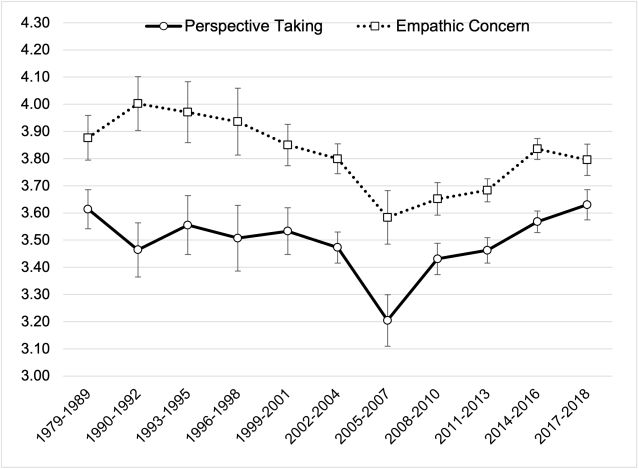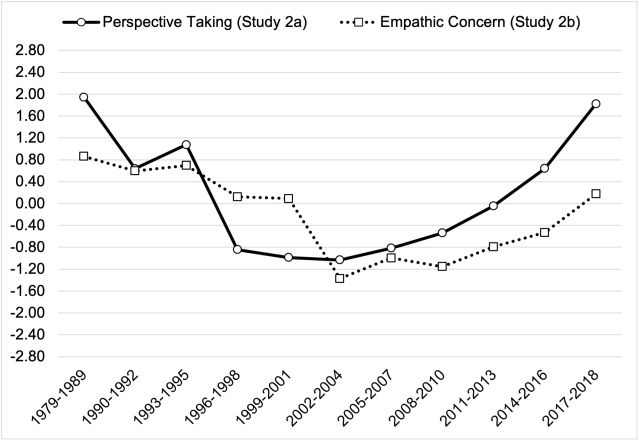Empathy
The Surprising Surge of Compassion in Modern Youth
Is the new cohort of young adults Generation Empathy?
Posted March 14, 2024 Reviewed by Gary Drevitch
Key points
- Historically, concerns about declining empathy among youth have been prevalent.
- Our new research reveals a surprising surge in empathic traits among American youth post-2008.
- Shifts in social interactions and perceptions may play a crucial role in empathy trends over time.
"The world is passing through troublous times. The young people of today think of nothing but themselves." –Peter the Hermit (1050-1115 AD)
Throughout history, each generation of adults has complained about the youth of their day. This complaint found support in research by Sara Konrath and colleagues, which noted a decline in empathic traits among U.S. undergraduates from 1979 to 2009. Simultaneously, self-centered traits like narcissism and individualism rose, painting a bleak picture of an increasingly self-absorbed society.
But the story doesn't end there. Konrath's and my latest research, extending beyond 2009, suggests an encouraging rebound in empathic traits.

Examining Published Research
Along with our colleagues, we re-examined published research that measured empathy in American undergraduates since 1979. Konrath and her colleagues reviewed research prior to 2009. We added findings from 126 new studies and six sets of data from our own laboratory that had not been published before. In total, we analyzed the responses of 38,693 undergraduates to get a clear picture of recent trends in empathy.
Our analysis focused on two types of empathy: empathic concern and perspective-taking. Both had previously shown declines over time. We used a statistical method known as cross-temporal meta-analysis and looked for linear changes such as an overall decline or overall rise in empathy over time. We also looked for fluctuations in empathy over time. We measured various characteristics of research participants, such as economic factors and broader cultural values to examine whether changes in empathy could be linked to shifts in these broader societal trends.
Although we did not find a significant linear change in empathy over the entire period, there was a notable wave-like trend. Perspective-taking and empathic concern remained relatively stable from 1979 to 1999, followed by a significant decline from 2000 to 2007. From 2008 onward, there was a significant increase. These trends remained robust even after accounting for various demographic, economic, and interpersonal factors. These results confirm that after a period of decline, both empathic concern and perspective-taking have recently increased among American undergraduates (see Figure 1).

Nationally Representative Surveys
We next wanted to confirm these findings using data from nationally representative surveys. We analyzed perspective-taking trends using data from the American Freshman Survey and empathic concern trends using the Monitoring the Future survey. These surveys provided annual responses from first-year college students and high school seniors, respectively.
The survey results reinforced our findings. Perspective-taking declined from 1979 to 1999, showed no significant change from 2000 to 2007, and then significantly increased from 2008 to 2018. Empathic concern showed a similar trend, with a significant decline from 1976 to 1999, no change from 2000 to 2007, and a marginal increase from 2008 to 2018. These results underscore the non-linear, fluctuating nature of empathy among young Americans, with a notable increase in recent years (see Figure 2).

Why Does Empathy Fluctuate Over Time?
Neither economic factors (such as the inflation rate or unemployment rate) nor worldview factors (such as trust in institutions or optimism about the future) explained these changes in empathy. Instead, changes in empathy were related to interpersonal dynamics, such as changes in how frequently people socialized and their feelings of loneliness. Empathy increased when socializing decreased and loneliness increased.
We were surprised to find that empathy levels were higher during periods of increased loneliness. This seems to contradict previous research suggesting that people with generally higher empathy tend to be less lonely. However, our findings align with a recent study that intentionally made participants feel lonely, which increased their motivation to empathize. It's possible that being lonely acts like a "social hunger," driving people to seek out and empathize with others. However, until more research investigates this link, it is premature to draw any conclusions about whether feeling lonely causes people to be more empathic.
Our findings challenge the narrative that empathy is steadily declining among American youth. The post-2008 increase in empathy, particularly in perspective-taking, offers a more optimistic view of young Americans today. However, the story of empathy is far from complete. Our society is continuously evolving, and with it, the factors that shape our ability to empathize. The COVID-19 pandemic, for instance, is likely to have had significant implications for empathy, given its profound impact on social interactions and worldviews.
Conclusion
Our research highlights the dynamic nature of empathy across generations. Research shows not only periods of decline but also remarkable rebounds and growth in empathic traits among youth. Contrary to the age-old adage of declining empathy among youth, our findings reveal a more complex and hopeful scenario: Young people are not uniformly less empathetic than their forebears; instead, the empathy of youth today ebbs and flows, much like the societal currents they are part of.
A version of this post also appears on SPSP Character and Context.
References
Konrath, S., Martingano, A. J., Davis, M., & Breithaupt, F. (2023). Empathy Trends in American Youth Between 1979 and 2018: An Update. Social Psychological and Personality Science, 0(0). https://doi.org/10.1177/19485506231218360




